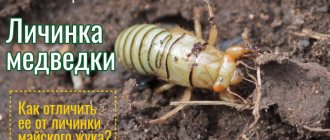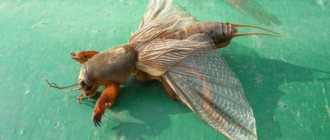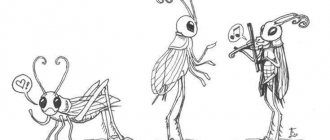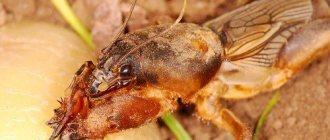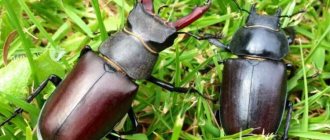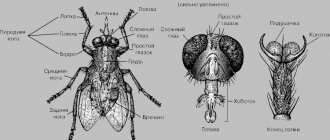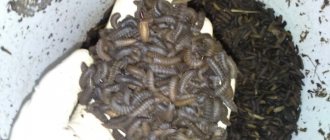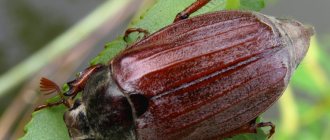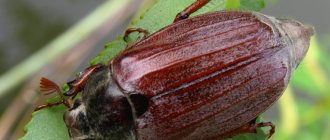What mole cricket larvae and adult insects look like
Adult insects lay up to 500 eggs during the mating season, which lasts from late May to mid-June. And in appearance, the dark brown eggs resemble millet seeds, and reach up to 3.5 mm in length.
In favorable conditions, larvae appear from them already on the 9-10th day. And in appearance they resemble adult insects, only without wings. Initially, the larvae reach up to 15 mm in length.
Adult mole crickets are larger. The length of their body reaches up to 50 mm, and the thickness is 12-15 mm. At the top it is brown-brown, and at the bottom it acquires a dark yellow tint. The surface of the body is covered with small, stiff hairs.
The mole cricket's mouthparts are a pair of powerful jaws. Next to them there are 4 tentacles, as well as 2 thread-like antennae. The insect's eyes are compounded, and they are located on the sides of the head.
The body of the pests is covered with a chitinous shell on the front. It not only protects the mole crickets from damage, but also helps in digging holes, because it is what they use to push out and compact the soil.
The abdomen consists of 10 tergites and 8 sternites. At its end there are anal and genital plates. The extreme segment has long and flexible tail appendages. Insects also have 2 pairs of wings and 6 limbs.
External features
Many people are concerned about the question of who the bear is. There are debates regarding two families: beetles or insects. The scientific classification is as follows:
- Class insects.
- Order Orthoptera.
- Superfamily Cricketaceae.
- The mole cricket family.
- Genus of mole cricket.
On a note!
The origin of this name can be explained by the Latin sound of the bear. It is designated as Gryllotalpa. In translation it sounds like a mole cricket, which is quite explainable by the external features of the mole cricket.
The optimal place where the insect lives is warm and moist soil. In the photo of the garden mole cricket you can see its impressive size, which can reach 8 cm in length, excluding paws and whiskers.
The mole cricket insect in the photo looks very menacing. The front part of the beetle is equipped with a powerful mouthparts and paws that resemble the limbs of a mole.
Appearance of the mole cricket
Upon further examination of the photo of the cabbage plant, attention is drawn to the shell, which begins immediately after the head. In case of danger, the mole cricket beetle hides its head in it. The adult also has wings on its abdomen, which are used by insects only during the process of reproduction.
To fully describe the structure of the mole cricket, it is important to mention its following features:
- Hind springy legs. With their help, the bear can jump.
- There are small claws on the front paws. They allow the insect to quickly dig through hard and dry soil.
- A photograph of a mole cricket shows a pair of whiskers on the front of its head. With their help, the insect catches odors.
- The hearing aid is located on the shins of the forelimbs.
The total lifespan of a mole cricket, taking into account the larval stage and other stages of maturation, is 3 years. Of these, the cabbage weed spends most of its life in the larval stage and only 1 year as an adult. The period for which a mole cricket lives may vary depending on the conditions surrounding it.
On a note!
During drought, the large cabbage grass travels considerable distances or goes deeper into the ground.
The following types of insects are known:
- ordinary;
- African;
- ten-legged;
- steppe;
- single-pin.
The easiest way to distinguish a male from a female is by the venation of the elytra. There are also individuals in which wing formation does not occur. These can be both males and females.
Description of the pest, its life activity
The mole cricket (photos and descriptions of the larvae are given in the material for reference) live under the surface of the ground during the day.
At this time, the insect breaks through passages, simultaneously destroying plants encountered in its path. And at this time it can burrow to a depth of up to 100 cm.
The cabbage plant comes to the surface only at night. At this time, she moves to other areas in search of food. And the insect can fly long distances.
Adult cabbage mushroom overwinters at a depth of 1 m, and young individuals and larvae hibernate at a depth of 25-30 cm.
May beetle and its larva
To get rid of cockchafer larvae
, it is necessary to establish the reason for their appearance, under what conditions the beetle and its larva can live well. It is necessary to remove comfortable living conditions for the beetle and the larvae of the cockchafer, creating conditions that are unbearable for the pest, so that it lays the larvae in another place, outside your area.
Also keep in mind that you should not confuse the larvae of the cockchafer and the larvae of the bronze beetle - after all, their nutrition is completely different, the conditions of reproduction and the lifespan of the larvae are also different. These larvae are very different in appearance from each other.
What harm does Medvedka cause to plants?
The mole cricket causes enormous damage to the crop. It gnaws through almost all flower, herbaceous and vegetable crops , which leads to their destruction, and also turns them onto the surface of the ground while making tunnels.
Mole cricket (photo and description) destroys plants by gnawing them
Insect larvae that feed on humus are also dangerous, which leads to soil depletion. And young cabbage weeds eat plant seeds planted in the ground.
Types of mole crickets
The term “mole cricket” unites about 100 species of large burrowing insects. All of them belong to Orthoptera and form one family. That's what they call it - mole crickets.
The family is divided into subfamilies:
- Gryllotalpa. The subfamily includes the common mole cricket, distributed throughout Russia.
- Scapteriscinae. Mole crickets of this subfamily inhabit almost all of South America and part of North America.
- Marchandinae. This subfamily includes the ten-toed mole cricket, common in the USA and Canada.
Insects of each subfamily are divided into genera. In Grulotaipa and Scapteriscinae there are 6 each. In Marchandinae there are 5. About half of the species are fossils. Other mole crickets are among those currently existing.
Which plants are susceptible to pest damage?
The diet of mole crickets is varied, and they can feed on a wide variety of plants:
- Vegetables: cabbage, beets, potatoes, tomatoes, onions, cucumbers, eggplants, radishes, peppers.
- Berries: watermelon, melon, strawberries, wild strawberries, grapes.
- Fruits: apple trees, pears, peaches, cherries, plums, apricots, cherries, peaches.
- Cereals: wheat, rye, corn, barley, rice, millet, soybeans.
Industrial crops are also not protected from mole crickets: flax, cotton, tobacco, hops, sunflower. The pest can also feed on the roots of young trees planted for decorative purposes, for example, spruce, oak, pine, and poplar.
Life cycle of a pest
The insect goes through 4 stages of development: egg, larva, pupa, imago (adult). With the arrival of spring after the leaves bloom, the summer of the May beetles begins, coming out of hiding. It lasts 1–1.5 months. At this time, mating occurs and in June the females lay eggs in the soil to a depth of 10–20 cm. Oviposition can be found not only in the ground, but also in the hollows of old trees. Each female lays up to 70–80 pieces and then dies.
After 4–6 weeks, thick yellow-white larvae emerge from the eggs. This stage is the longest, it takes place underground for 3–4 years. The larvae have 4 stages of maturation, accompanied by summer molts. In the first year, when the oral organ is not formed, young larvae feed on humus and small roots; from the next year their appetites grow and the larvae switch to feeding on the roots of trees, vegetables, and shrubs.
In warm weather, the larvae rise to the soil surface into the root layer, and with the arrival of winter they go 50–70 cm deeper. As they grow older, they become more dangerous. The pest grows and needs more food.
The larvae turn into immobile pupae at the end of the cycle - at the end of summer or at the beginning of autumn. After 1.5 months, the chitinous cover of the pupa bursts and adult insects appear. They will remain deep underground until spring comes.
Adult beetles live 1 year. It has been noticed that after 25–30 years there is a sharp increase in the number of pests. This is preceded by 3–4 years of decreased insect activity.
Folk ways to get rid of mole crickets
Traditional methods help to destroy mole crickets on a personal plot, however, they do not provide a 100% guarantee. But such methods are safe, and after their use the products remain environmentally friendly.
Kerosene
The mole cricket (a photo and description of the insect larva is given later in the article) does not tolerate kerosene. And this substance can be used to control pests.
To do this, 100 g of kerosene must be diluted in 1 liter of water, and the resulting solution must be poured into the insect burrows. For each of them, 30 g of product is enough.
You can also mix kerosene with sand (200 ml per 10 l). The resulting mixture must be spread along the paths between the rows. And the composition will repel the pest from the beds.
Soapy water
Soapy water is an excellent insect repellent and can be used to lure pests out of hiding.
To do this you need to follow these instructions:
- Tar or laundry soap must be dissolved in water (100 g per 10 l).
- The resulting product must be poured in a thin stream into the pest’s holes. For each move, it is enough to use 2 liters of solution.
- After some time, the pests will begin to crawl out of their holes. At this time, they should be destroyed in any way, for example, by cutting them with a shovel. The insects remaining in the holes that cannot find a way out will die on their own.
For this method, you cannot use regular toilet soap and washing powder. These products contain phosphates and other harmful substances that are absorbed into the soil and then enter the crop.
Eggshell
To use eggshells to fight mole crickets, you will need to first dry them, crush them and mix them with unrefined sunflower oil. The resulting mixture should be spread into holes in which seeds will be sown or plants will be planted.
The mole cricket is sure to feast on the crushed shell, which will lead to damage to the pest’s digestive system, and then to its death. And the mixture wound up in the soil will become an excellent fertilizer for plants.
Onion peel infusion
The mole cricket (photos and descriptions of the pest larvae are given later in the article) categorically cannot stand the smell of onion peels. So it should be used to combat insects.
To do this, you need to fill the onion peel with water at a temperature of 50-60°C (800 g per 10 l). The mass should be covered with a lid and left in a warm place for 4-5 days.
The resulting solution must be diluted with clean water in a ratio of 1 to 5. Then the liquid needs to be sprayed on the places that the mole cricket visits.
To prevent the appearance of the pest, it is worth placing some onion peels in the holes when planting plants. And most likely, cabbage will bypass such beds.
Rotten fish versus cabbage
The smell of rotten fish disorients the mole cricket, and because of this “aroma” the pest does not find the roots of the plants. So when planting seedlings, it is worth placing several small fish in the hole; sprat and herring are suitable.
They will quickly go rotten and make the bed unsuitable for cabbage. In the future, you will need to periodically dig a new batch of fish into the ground, deepening it by 10 cm.
Sunflower oil
When sunflower oil gets on the shell scales, it causes them to stick together. As a result, it becomes difficult for insects to breathe. So this feature can be used in pest control.
To do this, prepare a solution by mixing vegetable oil with water (15 ml per 4 l) . It needs to be poured into the holes and passages of insects.
When the oil gets on the pests and causes problems with their breathing, the cabbage mushrooms will come out. And they can be easily collected and destroyed by throwing them into a bucket of kerosene or crushing them with a shovel.
Needles
The mole cricket cannot tolerate the smell of pine needles, and the pest practically does not appear in areas where pine or spruce trees grow. But if it is not possible to plant these trees, then you can use their branches to repel insects.
To do this, finely chop pine, spruce or fir needles and spread the resulting mass between the rows. You can also dig it a little into the ground, then it will retain its aroma longer.
It is worth considering that the method does not lead to the death of pests. And because of the needles, mole crickets can simply move to a free place. So it is better to spread the mass over the entire territory of the site.
Yeast or beer trap
The smell of an intoxicating drink attracts mole crickets, and this “sympathy” can be used to combat the pest. To do this, you will need to prepare several bottles with a wide neck. A regular milk container will do.
They must be dug in between the rows, positioned at an angle of 45°. Moreover, it is important that the necks of the bottles are located flush with the soil surface.
Next, you just need to fill the container 1/3 of the volume with an intoxicating drink. Mole crickets, sensing the smell of beer, will crawl inside the bottles, but will no longer be able to get out. And all that remains is to occasionally check the traps and destroy the pests caught in them.
It is also worth remembering that over time, the smell of an intoxicating drink dissipates and weakens. So every 7 days you need to add a new portion of beer to the traps.
Manure or compost trap
The mole cricket (photos and descriptions of the pest larvae will help you quickly recognize it) loves the smell of manure and often lays eggs in it. So it can be used to control the pest.
To do this in the fall, you need to make several trap holes around the perimeter of the garden, with dimensions of 50*50 cm, and fill them with manure, preferably horse manure.
The mole crickets will crawl inside for the winter, and when the cold comes, it will be enough to simply dig holes and pull the pests out. Then they will quickly die in the cold.
In the spring, you can simply lay out piles of manure, keeping a distance of 5-6 m between them. The mole crickets will crawl inside and lay eggs there. All that remains is to periodically check the piles, and if you find masonry there, you should immediately destroy it.
Water or sweet trap
You can destroy mole crickets using ordinary water and honey.
And to do this, just follow these instructions:
- An ordinary glass jar or bottle should be filled with water to 1/3 of its volume.
- The neck and inner surface of the container should be greased with a thin layer of honey.
- The jar must be dug into the ground at an angle of 45°. It is important that the neck of the dish is flush with the ground.
To achieve maximum results, you should build several similar traps on the site, placing them at a distance of 5-6 m from each other. As a result, the mole crickets will be attracted by the smell of honey, and they will crawl inside the dish to feast on the sweet mass.
But they will no longer be able to get out, and will drown in the water. All that remains is to periodically check the traps and remove dead insects.
Homemade fabric trap
In the summer heat, the mole cricket prefers to hide in the shade: under stones or leaves. And this feature of the pest can be used against it.
To do this, you will need to lay out a piece of dark fabric in several places on the site. Insects will definitely crawl under them in search of shade. And all that remains is to occasionally lift the material and check the trap, and if pests are detected, immediately destroy them.
In the spring, immediately after the snow melts, instead of fabric, you should lay out pieces of plywood, cardboard or boards around the area. Such traps will attract mole crickets, which will crawl under them in search of warmth.
Reproduction
Reproduction of the mole cricket
The period when the mole cricket lays eggs occurs at the beginning of summer. At this time, the optimal soil temperature is reached. Taking into account this feature, experts recommend carrying out not only control, but also preventive measures before sowing.
When the time comes, the female goes 10 cm or lower. At the indicated level, the mole cricket’s passages on the ground take on a horizontal shape. The insect builds a special chamber in which eggs will be laid.
Chemical methods
The mole cricket, a photo and description of which is given in the article, is easily destroyed with the help of chemicals. Moreover, such products help get rid of not only adult cabbage weeds, but also their larvae.
And some drugs also additionally destroy garden ants, wireworms and other pests. And such means are considered the best.
| Features of the drug | Application | |
| "Medvetox" | The product is produced in the form of small red granules, and its active ingredient is diazinon. The drug does not destroy soil microflora and does not harm earthworms. | The granules should be buried in the soil to a depth of 3-5 cm. Some gardeners recommend moistening the product in vegetable oil to make it more attractive to the pest. The product begins to act 4 hours after being placed in the soil. And it protects the area from the invasion of mole crickets for 2-3 weeks. A package of product (100 g) is enough to treat 50 square meters. m plot. |
| "Antimedvedka" | The product is produced in the form of microgranules, and its main active ingredient is imidacloprid. Helps destroy mole crickets, cockchafer larvae, wireworms and black ants. Suitable for protecting all vegetable crops, with the exception of greens and radishes. | The drug must be spread between the rows. But it is better to dig it into the ground to a depth of 2-5 cm. Otherwise, birds or pets may feast on the poison. For processing 15 sq. m area, 20 g of the drug is enough. |
| "Medvecid" | Red granules, the main active ingredient of which is imidacloprid. The product effectively destroys mole crickets, as well as garden ants and beetle larvae. At the same time, the drug is safe and does not destroy the soil microflora. | The granules should be dug into the soil to a depth of 2-5 cm in places that the cabbage plant is supposed to visit. For prevention purposes, it is worth using the drug before sowing or planting plants. For processing 10 sq. m area you will need to use 100 g of the product. |
| "Rembek" | The drug is produced in the form of a grain mixture treated with insecticides (chlorpyrifos and imidacloprid). | The toxic mixture must be poured into the pest's holes, using 2-4 g (0.5 tsp) for each hole. After application, the exit should be compacted and the soil should be slightly moistened with water. A package of product (360 g) is enough for an area of up to 100 square meters. m. The garden will need to be treated with the drug 7-10 days before sowing and planting, as well as during the breeding season of the pest (late May - early June). |
| "Karbofos" | A pesticide that is produced in the form of a clear liquid or water-soluble white powder. And the main active ingredient of the drug is malathion. The insecticide perfectly destroys adult insects and their larvae, but does not harm oviposition. | Karbofos itself does not attract mole crickets, so you need to prepare poisonous semolina with this drug. To do this, boil wheat, barley or rye in salted water. For 1 kg of the resulting porridge you will need to add 20 g of vegetable oil (preferably unrefined) and 25 g of the drug. The product should be dug into the ground at the rate of 6-8 g per square meter. m plot. |
| Calcium carbide | This substance is not actually a pest control agent. But thanks to him, you can get rid of the mole cricket for a long time. | Having discovered pest tunnels, 5 g of the substance should be placed in each of them. Then you need to water the area. When interacting with water, calcium carbide will release acetylene. This poisonous gas will quickly fill the pest's passages, which will lead to the instant death of all cabbage mushrooms living there. |
Any chemicals intended to combat mole crickets are strong poisons. Therefore, when using them, safety precautions must be observed. Before processing, be sure to wear protective equipment: gloves, long sleeves and a respirator.
While using the medications, you should not drink, eat, or smoke. After the procedure, you need to wash your hands with soap and take a shower.
The event itself should be held on a cloudy, windless day, at a temperature no higher than +25 °C. The drugs must be stored in a place inaccessible to children and pets, and only in sealed packaging.
All methods of fighting Medvedka
Having seen tubercles and dead plants on the plot of land, a mole cricket has definitely settled in your home. There are traditional and modern methods of destruction to eliminate it, but it cannot be destroyed immediately; it will take two to three years.
To effectively kill the parasite, it is better to combine several control methods. At the initial stage, it would be better to use a method that will not contaminate the soil with plants with caustic chemicals.
- 1. repellent,
- 2. loosening the soil,
- 3. destruction of nests,
- 4.use of special traps,
- 5. chemical and biological preparations.
To loosen the soil, try the agricultural method
This method is used when spring comes, after the snow has melted, thus destroying the dug passages. It becomes more difficult for parasites to move around the area. The destruction of clutches, adults and their larvae is also underway.
It is important that the loosening depth is 15 cm. And repeat digging after the growing season
Another control method is a manure trap.
In the fall, you need to dig 50 cm holes around the garden, filling them with fresh organic fertilizers. And when the cold comes, the parasites will move into these pits to secure a place for themselves for the winter. After waiting for severe frosts, dig up the manure and spread it on the surface, and the cold will kill them.
There is another option: when you see the tunnels, pour water with oil or soap there, the mole cricket from such a cocktail will come to the surface, and then you catch it to destroy it. But this is the most ineffective way.
There is an interesting method with alcohol
The mole cricket is very attracted to the smell of beer; kill the beetles with the help of this drink. Take a glass bottle one-third full and bury it at a slight angle, so that there is a gap of 1-2 cm at the neck. At night, the smell of beer will attract its lover, who, intoxicated by the smell, will fall into the bottle, but will not come back out. Accumulated beetles in a bottle can be easily eliminated.
Obstacle method
You can also create physical obstacles for them to fight, since the mole cricket is not able to overcome some difficulties along the way. This is a way to prevent beetles from feasting on plant roots. You need to take nylon tights, make them into bags filled with earth. You plant seedlings in it. The edges of the container should protrude 3 cm from the soil surface. This way you protect tomatoes, eggplants, etc. from the pest.
If traditional methods are not effective in eliminating the enemy, then a number of different chemical preparations are provided to your attention: Anitimedvedka, Medvetox, Rembek, Medvetsid. Use medications strictly according to instructions! And use chemical protection products.
In addition to chemical weapons, there is also a biological remedy against the mole cricket. Biological drugs infect parasites with harmful organisms. For example: Nemabact, Boverin
Attention, do not use the drug frequently, as they develop immunity to these poisons
To prevent the mole cricket from becoming a permanent resident in your garden, you need to carry out preventive maintenance of the area. 1. Digging up the area in spring and autumn, 2. Replace chicken droppings with chicken droppings, it is safer, 3. Plant and place repellent plants in the garden and around the entire perimeter, 4. Monitor the humidity level and do not allow it to exceed the norm.
Biological drugs
Biological preparations are no less effective at destroying mole crickets than chemical ones. Such products contain fungus or special bacteria, which, when interacting with pests, lead to their death.
The best drugs of this type are considered:
- "Nemabact."
- "Boverin".
- "Entocide."
- "Ecokiller".
Biological agents are not dangerous for people, pets, and birds. In addition, they do not destroy the soil microflora and do not lead to the death of beneficial insects. And they can be used both for pest control and for prevention purposes.
How to detect an appearance in the garden
The insect, of course, is secretive, but all living things leave traces. Including in the literal sense of the word. Early in the morning, before the dew has dried, the insect can be detected by the trail of the abdomen, which it drags behind itself.
You can suspect the presence of pests by looking at young, drying plants. If it turns out that the seedling's stem has been chewed, it is almost certainly a mole cricket. Other garden pests gnaw roots or eat leaves.
Later, characteristic holes appear in the ground. The hole of a mole cricket and a mole cricket can be confused, but in a cricket it is 1 cm in diameter, and in a mole cricket it is 2-3. However, the cricket has the same food supply and does almost as much harm.
Barriers for insects
To prevent pests from entering your garden or vegetable garden, you can create natural barriers. It is much easier and safer to plant plants with a pungent odor around the perimeter of the site that repel mole crickets.
The pest especially does not like the aroma of garlic, coriander, valerian, mint, chrysanthemums and marigolds.
Protective rings
Thanks to this method, plant seedlings can be protected from pests. To do this, you will need to prepare several plastic bottles with a volume of 1.5-2 liters. Mayonnaise buckets, dairy products glasses, and any plastic dishes with a height of 20 cm are also suitable.
The bottom of the workpieces must be cut off so that protective rings are formed. They should be buried in the ground so that the walls protrude 5 cm above the ground surface.
Then the mole crickets will not be able to crawl to the plants along the surface of the soil. It is necessary to plant seedlings inside the resulting protective rings, and they will be protected both from above and from below.
Fencing
The beds can be protected from mole crickets by digging sheets of plywood, boards or pieces of slate around them, as well as a mosquito net. Such limiters should go into the ground to a depth of 20-25 cm, and their upper part should rise above the soil surface by at least 5 cm.
Gardeners also advise putting nylon stockings on the roots of plants before planting them. But this method is quite time-consuming, especially if a large number of seedlings are planted.
The daily bustle of an individual
Having previously examined the part about what a mole cricket looks like, we can say that the individual prefers to lead its lifestyle away from human eyes, namely in the upper layers of the soil.
With daily labor, these insects make trenches in the ground, eating everything in their path. At night, the mole cricket crawls out to the surface of the earth, trying to remain unnoticed.
Mechanical and electrical repellers
Electrical and mechanical repellers are often used to combat mole crickets. Such devices help repel insects, and at the same time they are harmless to health and do not harm the soil and crops.
But repellers have several disadvantages. First of all, they do not destroy pests, but only force them to move to another area, which will not please the neighbors at all.
And the effect of repellers appears after 10-14 days. And during this time, the pest can destroy a significant part of the crop. Another disadvantage is that repellers must work non-stop all season. Otherwise, the insects will return to the site.
How to understand that an area is infested with a mole cricket
The probability of seeing a mole cricket during the day is negligible, which creates some difficulties in determining whether an area is infested with this pest.
A combination of signs indicates the activity of an insect:
- mass death of seedlings;
- wilting of plants;
- damage to root crops;
- the appearance of small loose piles of earth;
- earthen paths visible on moist soil;
- holes in the ground (entrance to the burrow).
Larvae and adult mole crickets harm crops, damaging their root system. They feed on the roots of plants: tomatoes, potatoes, carrots, cabbage, eggplants, peppers, ornamental flowers, and cereals. Adult insects are more omnivorous than larvae. A developed individual readily eats worms, small insects and large beetle larvae.
Advice. Clean the area thoroughly in the fall after harvesting. With the beginning of spring, when the top layer of the earth warms up to 10-15 degrees, mole crickets emerge from their winter holes and begin to feed on the remaining fruits.
An adult mole cricket feeds on plant roots and can damage up to 15 plants per night
Prevention
The mole cricket can be removed from the site, but it is not a fact that the pest will not return again.
And to prevent this from happening, it is better to take the following preventive measures:
- In early spring and late autumn, you should dig up the soil to a depth of at least 25 cm. Thanks to such measures, you can destroy possible clutches of pest eggs and adult individuals.
- Along the perimeter of the site it is worth planting plants that the mole cricket cannot tolerate. These include alder and bird cherry.
Preventing the appearance of mole crickets
You can also use branches of these crops, which will need to be stuck into the ground in different places in the garden. It is also worth planting marigolds, chrysanthemums and calendula on the site. These flowers repel pests.
- Before sowing and planting, the holes should be shed with iodine solution. It is also advisable to put a clove of garlic in each cavity. Crop seeds need to be treated with fungicides.
- The perimeter of the site, paths and row spacings must be sprinkled with sand and kerosene.
- During the growth of plants, they, as well as the soil in the garden bed, should be periodically sprayed with an infusion of onion peels.
Mole crickets are dangerous pests that can destroy almost the entire crop in a short period of time. Moreover, insects and their larvae, which, judging by the photo and description, look threatening, damage both the underground and above-ground parts of plants.
So you need to fight them at the first signs of their appearance. Better yet, prevent pests.
Mr. Summer resident advises: preventing the appearance of mole crickets
Due to the rapid reproduction, vitality of the insect and the structural features of its body, it is quite difficult to fight mole crickets. To prevent the appearance of cabbage, you should perform the following preventive actions:
- Do not use fresh manure as fertilizer.
- When planting in open ground, place the roots of seedlings in cups made from plastic bottles with the bottom cut off.
- Form a mulch layer on the beds. Pine needles work well.
- Add chicken manure to compost heaps, which will prevent the reproduction and appearance of mole cricket larvae.
- Sow marigold seeds around the perimeter of the beds or simply bury leaves or flowers in the soil. You can also use chrysanthemums, which have a specific smell that the earthen crayfish does not like.
- Plow the soil before the onset of frost; cold air is detrimental to insect egg laying.
The mole cricket is a serious pest that creates many problems and destroys crops, however, knowing the characteristics of the mole cricket, its way of life and familiarizing itself with the variety of ways to combat the pest, you can choose the most convenient and effective one.
What to look for when recognizing
Even looking at photos of two types of larvae, you can replace the difference and see that they have nothing in common. Body structure, lifestyle, diet are different. The peculiarity of the mole cricket is in the front pair of legs, which look like a tool for digging the earth. In addition, both representatives belong to different groups. May beetles are Coleoptera, mole crickets are Orthoptera, their closest relatives are grasshoppers and locusts.
In fact, the mole cricket larva is a copy of the adult individual, but differs in size. With each stage of development, the dimensions increase. May beetles are completely different, they have a worm-like shape, visually reminiscent of a large white caterpillar with a red head. Length up to 2 cm, thickness 1 cm, 3 pairs of paws in front.
It is important to identify the larvae promptly, as they can cause serious damage to crops and plants by destroying roots. Nutritious and loose soils are considered optimal for habitat. In the summer they love potatoes and corn, and to eliminate them you will need to use insecticides
In the summer they love potatoes and corn, and eradication will require the use of insecticides.
https://apest.ru/medvedka/vse-o-medvedke/lichinki-majskogo-zhuka-i-medvedki/https://vogorode.pro/lichinki-v-komposte-lichinki-medvedki-bronzovki-majskogo-zhuka/ https://gdeklop.ru/medvedka/otlichia-lichinki/
Folk remedies
Experienced gardeners and gardeners know how to deal with mole crickets using improvised means. Therefore, they use the following traditional methods.
Beer traps
Bears are not able to resist this drink. Traps are made from glass jars or bottles: a jar is dug into the ground (at an angle), 50 g of beer is poured into it, and a gauze is tied on top. The insects gnaw through the gauze and fall into a trap from which they cannot escape. After some time, the jar will be tightly packed with mole crickets and they can be easily destroyed.
Traps with honey
Another option for getting rid of mole crickets using folk remedies is to use honey traps.
They are built on the principle of the previous method, but beer is replaced with honey, and instead of gauze, a piece of iron or cardboard is used, which only covers the jar halfway. When the trap is full, it must be replaced with a new one.
Eggshell
In winter, you can collect eggshells. It is mixed with vegetable oil and poured into the holes dug by the mole cricket. Such a treat can also bring the mole cricket out of the area. You can also grind the shells into powder and mix them with the soil on which you plan to plant the plant. If an insect tastes the shell, it will die.
Using odors that are unpleasant to mole crickets
Certain odors repel these pests. These include aromas:
- mint and garlic leaves, onion peels (spread directly on the beds);
- branches of pine needles, willow, alder, chrysanthemum (dig into the ground);
- marigolds, calendula, beans, flax (planted in different places in the garden);
- fish heads and tails (buried in beds between plants).
These odors can protect against mole crickets for 2 weeks (with the exception of growing sources of odors).
Loosening the soil
The soil is loosened at least 3 times a season. By digging the ground to a depth of 15 cm, you can find mole cricket burrows. This type of gardening work is carried out with a hoe, and after finding nests, they move the soil with insects, larvae and eggs into a bucket.
Dung piles as bait
You can remove the pest by arranging manure traps: piles of manure must be spread throughout the area. With the onset of warm days, mole crickets will certainly crawl into them and begin to create holes in them for laying eggs. After checking such a trap and finding insects in it, it must be burned. In this case, the adults will be destroyed along with the larvae.
This is a very effective way to control pests. You can prepare a “wintering place” for the pest in advance. To do this, in late autumn, they dig holes in different places in the summer cottage and fill them with compost or manure. With the onset of frost, the contents of the pits are scattered onto the surface with a shovel. The insects do not have time to penetrate deeper into the soil and freeze.
